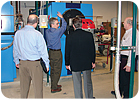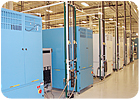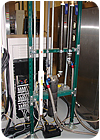
Phil Seamon, a principal engineer from Harley Ellis Devereaux (second from left), points out features of the Buderus condensing boilers in the mechanical/electrical room.
The new Bosch Corp. Technical Center, completed in March, features a closed-loop heat pump system, designed to recover heat generated from test chambers and equipment in the facility’s laboratories. The recovered heat is then used to control the temperature throughout the 212,000-square-foot facility.
The $37.5 million technical center will house research and development for the company’s automotive body electrical and electronics division. Initial plans are to bring over 475 employees from a nearby facility. Future plans are in the works that could eventually expand the facility size to 1 million square feet on the 76-acre site.

Rows of test chambers make up one of the main sources for heating and cooling the entire Bosch facility via a closed-loop water-source heat pump system.
The system was designed by Harley Ellis Devereaux of Southfield, Mich. and installed by Bumler Mechanical of Sterling Heights, Mich.
Domke explained that the entire system is comprised of over 200 individual McQuay variable-speed heat pumps for the 200-plus zones throughout the test labs and office space.
The source of heat for the system centers around the areas used for testing automotive components. Individual thermo and vibration test chambers are hooked up to the two-pipe system, which uses the heat generated from the chamber as the main energy source, making the entire system self-sufficient.
“We don’t throw the heat outside as in a normal system,” said Domke. “The heat is recovered and used again.”

Thermal test chambers in the Bosch test labs are connected to the closed-loop water-source systems via pipes which return heat generated from the chambers back into the two-pipe system, providing a source for heating or cooling the facility.
FEATURES OF THE SYSTEM
Besides the individual heat pumps, sized to handle a number of different-use zones, the closed-loop system also features two Buderus condensing boilers and two Baltimore Aircoil cooling towers. According to Bumler Mechanical’s Randy Pagel, his only real challenge was allowing enough lead-time to get the boilers and have them approved.“Some of the materials, including the boilers, were from Germany,” he said. “So we had to allow for a long lead time to get them. We had to jump through a few hoops to make sure all of the boiler pressure ratings passed Michigan codes.”
The boilers, which Pagel said are “high-efficiency boilers and usually run on low fire most of the time” are contained in the facility’s smaller-than-average mechanical room.
“The system is very flexible as well as very efficient,” said Phil Seamon, one of the principal engineers from Harley Ellis Devereaux. He noted the efficiency is evident in the size of the mechanical room. While many buildings the size of this facility with expansion plans might require a 22,000-25,000-square-foot mechanical-electrical room, the Bosch mechanical-electrical room is only 7,000 square feet.
Seamon said this type of design has a heavy European influence; as many of the newly constructed European buildings utilize HVAC systems as part of an overall green strategy - using sustainable energy to help the environment. In addition, the facility will include a storm water management system, allowing runoff water to be absorbed into the soil rather than being retained in a holding pond.
“We have blended technology from the U.S. and Europe to have the best of both,” he said. “This blend will be a new standard for North America. It is certainly not a typical Bosch building.”
Being atypical can be a very good thing, especially when it comes to comfort and operational efficiency. Even on some of the coldest days (the outside temperature was in the single digits the day ofThe NEWS’visit), the boilers do not have to work very hard. In fact, on this day Seamon said the boilers weren’t running at all. “We get a lot of energy recovery from the process heat rejection,” he said.
The equipment is sized to fit the current building envelope and there is room to add more major components for the ultimate growth of the facility, both in the mechanical room and on the roof.
The flexibility of the system is evident in the location of the individual heat pumps, located near the ceiling, as opposed to being on the roof. This makes them easily accessible for routine maintenance and service by the Bosch maintenance staff. There are virtually no heat pumps above the office spaces and those that are there can be easily accessed via ceiling panels marked with an identifiable numbering system.

Phil Seamon, a principal engineer from Harley Ellis Devereaux (left), points to the large heat wheel contained inside the Innovent air handler on the roof of the Bosch facility. Harold Domke, director of facilities for Bosch, is on the right.
“We will service the building automation equipment, boiler maintenance, or cooling towers because of our experience level,” said Pagel.
And speaking of the roof, the Innovent air-handling equipment collects all of the exhaust air and intake air in one location.
The equipment features a heat wheel, which takes heat from the exhaust side and passes it over outside air on the intake side, sending tempered, fresh air to labs and office spaces. This operation ensures precooled air during warm months and preheated air during cold months.
The beauty of the many different zones and two-pipe system is the comfort level for building occupants. If an office or conference room is facing the sun and requires cooling, the heat pump will send cooler, filtered air to the space. Meanwhile, at the same time, a lab in a different location may need to heat up its space. Once again, the flexibility of the system allows for warm, tempered air to be sent to the lab space. This tempered air originates as exhaust air from the test chambers.
GOOD BUSINESS SENSE
The construction team of Harold Domke, general contractor Barton Malow, and Bumler Mechanical made great business sense on this project. A competitive bid along with Bumler’s experience with heat pumps made Bumler the most logical choice for this installation.“Harold likes things that make good business sense, and in this application he likes his heat pumps,” said Pagel. “And we’ve had a lot of experience installing heat pump systems.”
At its peak, Bumler had 12-14 pipefitters, sheet metal workers, and temperature control specialists working at the facility for the project, which lasted 18 months. Pagel added, “From a sheet metal standpoint, it was fairly easy work because of the small systems. There were a lot of zones but utilizing very small-sized ductwork.”
Pagel noted this system design is unique to the area, but it makes a lot of sense. “You might see more of this same design now that Harley Ellis Devereaux has worked with this system, but you have to get an owner to buy-in and an acceptance level from the end user,” he said.
And although the building was not necessarily designed to attract a lot of attention, its features will be speaking loudly for themselves. “This facility was not intended as a showcase, rather, it is a technical center,” said Domke. “But it has turned out to be a showcase. The overall goal is technology meeting nature.”
Publication date:04/16/2007

Report Abusive Comment